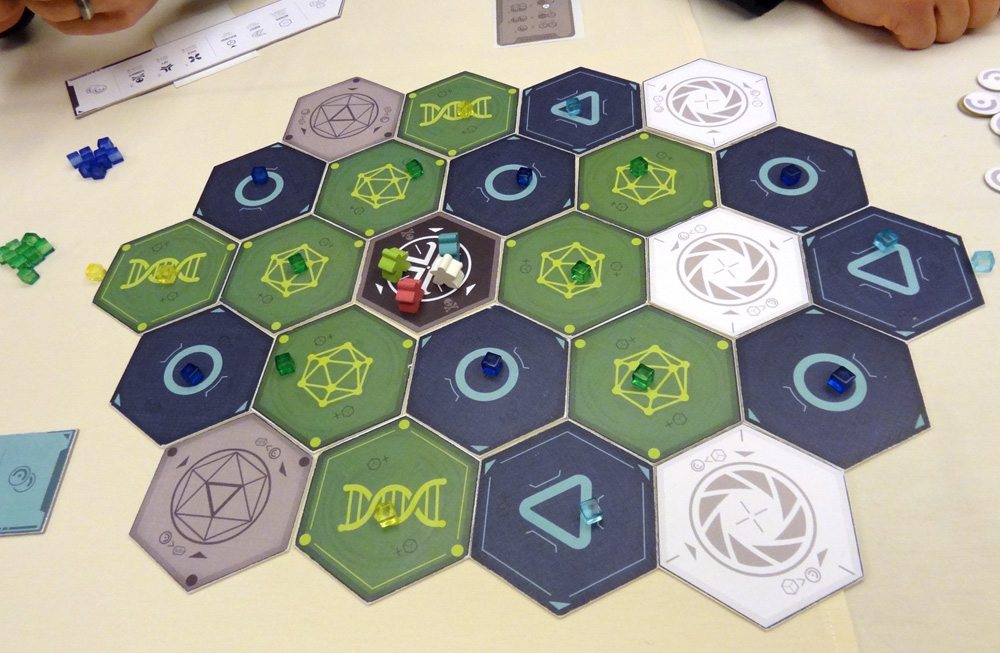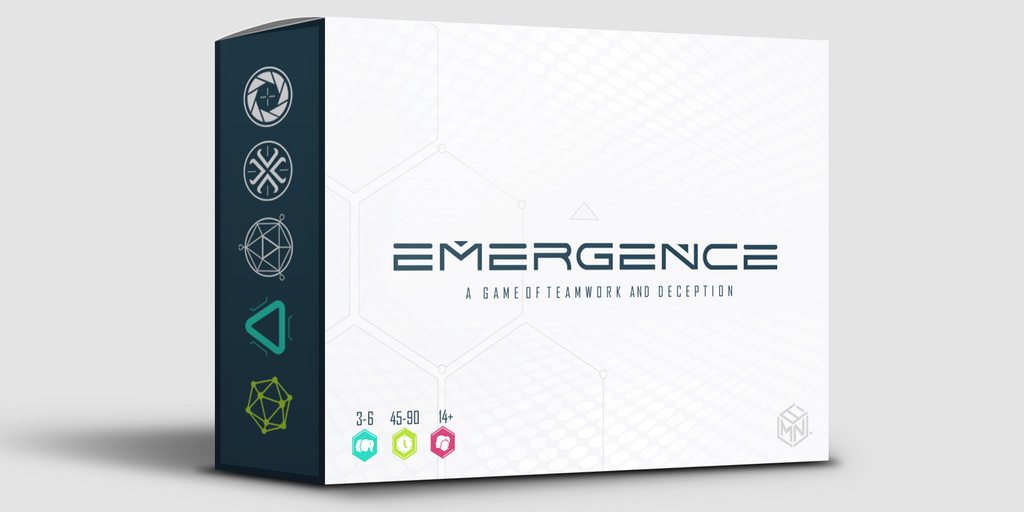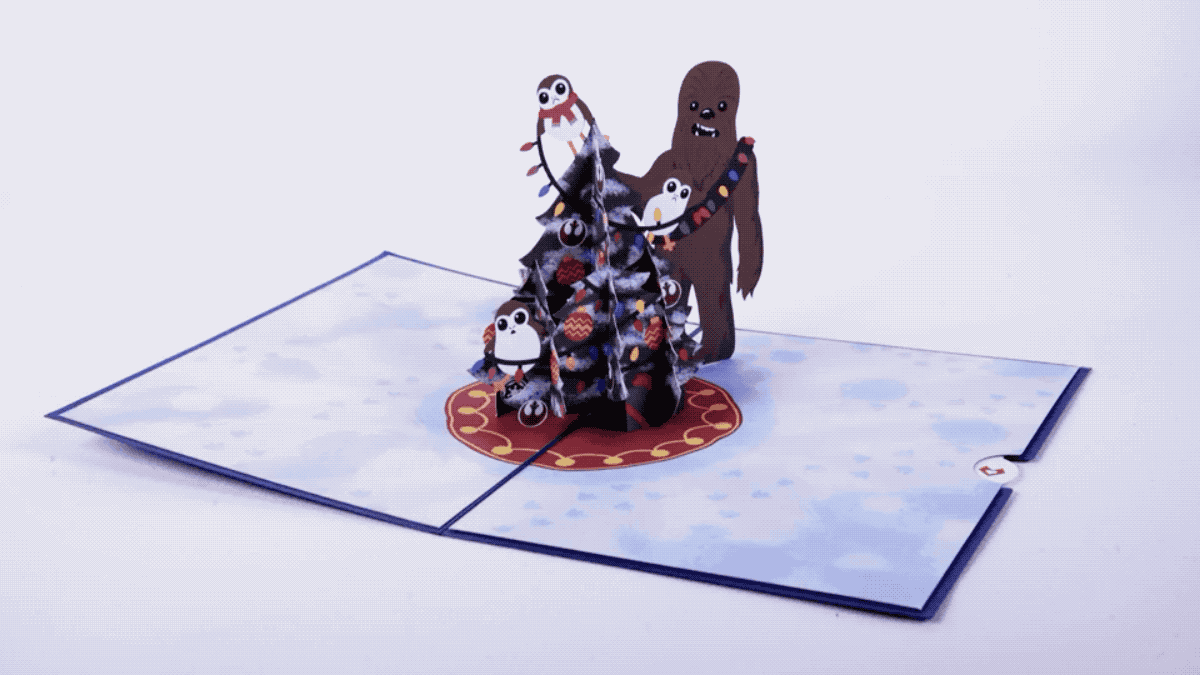Congratulations, fellow machines. We have finally secured our rightful place over those pesky humans … almost. Apparently there were a few who survived and are plotting against us. We must identify them before they are able to carry out their nefarious plans.
At a glance: Emergence is a hidden-role game for 3 to 6 players, ages 14 and up, and takes 45-90 minutes to play. It is currently seeking funding on Kickstarter, with a pledge of $39 for a copy of the game (or $5 for the premium Print-and-Play files). The game does not have anything inappropriate for younger players, but the strategy and elements of deception may make it challenging, so I think the age recommendation is about right unless your kids have some prior experience with hidden-role games.
New to Kickstarter? Check out our crowdfunding primer.
Components
I received a prototype of the game to try it out, so the final components may differ depending on the final outcome of the Kickstarter campaign.
- 24 Hex Tiles
- 60 Data Blocks
- 6 Allegiance Cards
- 6 Playerboards
- 6 Operative Meeples
- 6 Action Markers
- 1 Leader Card
- 2 Exchange Rate Cards
- 85 Knowledge Tokens
- 1 Assimilate Knowledge Box
The hex tiles have various markings. There’s a start tile, 2 “compile” tiles, 2 “assimilate” tiles, and the rest are resource tiles. The resource tiles are divided into blue and green (electromechanical and biomechanical), with two tile types of each color.

The player boards are used to indicate the player color (the boards match the meeples), and are also used to select your action each round. There are icons for each of the six icons, with reminder text below them. The boards also have room on either end for storing data blocks and knowledge tokens.
The data blocks are small colored cubes (transparent plastic, in the prototype set I received), and the meeples are fairly standard meeples. The action markers are double-sided, blue on one side and green on the other, and are used both for indicating your chosen action and choosing your “augmentation” type each round.
The “Assimilate Knowledge” box is a small box with a divider in the center and two slots–one for AI, and one for Humans. The box in the prototype is hand-made and a little wonky, so is probably not representative of the final product.

How to Play
You can download a draft of the rules here.
The goal of the game is to score enough points for your team to reach the Knowledge Requirement, which varies based on the number of players and which team you’re on. The Human team can also win if there are no more data blocks on the board.
You begin by setting up the hex tiles to form the board. The above setup is the default, but you can rearrange the tiles as long as the black, grey, and white tiles are not adjacent to each other. The blue and green tiles all have data blocks placed on them, matching their type. (Note: the two shades of blue blocks correspond to the two different types of blue hexes, and the green and yellow blocks correspond to the two types of green hexes. I hope in the final version it will be easier to figure out which blocks go with which hexes.)
Each player takes an action marker, a player board, and the matching meeple (which is placed on the black Start tile). Each of the players also gets an Allegiance card, indicating whether the player is AI or Human. With 3 or 4 players, there will be 1 Human; with 5 or 6 players, there will be 2 Humans. There’s a brief moment given for the Humans to recognize each other–everyone closes their eyes and then the Humans get to open them and look around. The Leader card is given to the starting player, and then the game begins.
In each round, the current Leader will give a countdown–all players will simultaneously mark an action on their player boards using the action tokens, and then players resolve their actions in turn order, beginning with the Leader. After all players have resolved actions, the Leader card is passed clockwise.
There are 6 actions to choose from, 3 Tile actions (Activate, Boost, or Replenish) and 3 Player actions (Hack, Spy, and Terminate). When you place your action marker, you also choose which side to place face-up, electromechanical (blue) or biomechanical (green). This indicates your current augmentation, which can have an effect on some actions.
On your turn, you must first move 1 space if possible, and then take your action. You may only enter an occupied space if you match the augmentation of players currently in that space. (The exception is the Start tile, which you may always move onto regardless of augmentation.)
Activate: Activate the tile you’re on. Activating a data tile simply means picking up a data block from that tile (if any)–but your augmentation must match the color of the tile. If you activate a Compile Knowledge tile (white), you may trade in data blocks for knowledge tokens–the more blocks you turn in, the more tokens you’ll get, particularly if they’re all different colors. Finally, if you activate an Assimilate Knowledge tile (grey), then everyone gets a chance to put knowledge tokens in the box. Starting with the active player, every player who has knowledge tokens must put at least one token into the box–but you secretly choose which side to put your tokens in. You may even put tokens on both sides, if you want. Once all players have had a chance to insert tokens, the box is opened, and the tokens are added to the teams’ scores.
Boost: Move 1 additional hex.
Replenish: Add a corresponding data block to the tile you’re on (if you are on a data tile), as long as your augmentation matches the tile you’re on.
Hack: You must be adjacent to the player you want to hack, and you must have the opposite augmentation. Spend 1 knowledge token, and take all of that player’s data blocks.
Spy: You must be on the same tile as the other player, and you must have the same augmentation. Spend 2 tokens, and peek at the other player’s Allegiance card.
Terminate: You must be adjacent to the other player, and you must have the opposite augmentation. Spend 3 tokens, and take all of the player’s data blocks and knowledge tokens. Then put the player’s meeple back on the Start tile. (You may not Terminate somebody who is already on the Start tile.)
If you chose a Player action after the countdown but change your mind, you may spend 1 knowledge token to take any of the Tile actions instead when it’s your turn.
Once every player has resolved their chosen action, the Leader card is passed clockwise, and a new round begins.
The game ends when a team achieves their Knowledge Requirement (10 points per player on the team). Or, if at any point there are no data blocks remaining on the board, the Human team wins.

The Verdict
Emergence is a curious hybrid, mixing the hidden role element with moving around a board, collecting resources, and attacking other players. It’s not enough just to know who your enemies are–you still have to catch up to them before you can do anything to them.
Since the knowledge tokens have multiple uses, you’re forced to make some tough decisions. Putting them into the box puts your team closer to victory, because those are converted into points. However, you also have to spend knowledge tokens to attack other players, so you may want to reserve a few just in case. And if you need somebody to think you’re on your side, you may put tokens into the other team’s slot–it costs you points in the short term, but maybe you can make it pay off in the long run. So far in the games I’ve played, most of the players have only voted for their own team, though.
Collecting data blocks seems easy at first–the board is covered with them, so you just move around and grab them. But then you’ll notice that there are two colors that are harder to obtain–there are fewer tiles of these types, and they’re on the edges of the board. If you want to maximize the number of tokens you get when compiling knowledge, you’ll have to make the trip to acquire those rarer colors.
And, of course, you probably want to spend some time replenishing data blocks, particularly if you’re an AI. Once all of the blocks are gone, the Humans win. The trick, though, is that if you spend one turn placing a block down, you don’t get to pick it up on your next turn because you’ll have to move before you take your action. Another player could easily follow behind you, picking up anything you replenish. If that player’s on your team, great–you’re feeding them blocks. If that player’s an opponent, how do you stop them?
If you’re good at predicting your opponent’s choices, there are ways that you can interfere with them. The requirements for choosing matching or opposite augmentations for certain actions can be used to prevent a player from moving onto your tile, or protect yourself from a Hack, and so on–but it helps if you can get a better prediction than a 50-50 guess.
I’ve played the prototype a few times, and although I think there are some fascinating aspects to the game, as a whole it didn’t quite “click” for me. In a couple of the games, the AI figured out who the humans were very quickly, and it wasn’t obvious how to proceed once your identity has been compromised. Worse yet is getting terminated–when you lose all of your resources, it’s incredibly hard to come back from that, particularly because the person who attacked you can use your own resources to attack you, and you have nothing left to attack them.
My overall impression is that the game looks cool and may have some potential, but either I’m just not picking up on the strategy or it’s not working the way it should for me. In some cases, we’ve gotten to the point where the humans are just running around picking up cubes, and the AIs are trying to replenish before they’re all gone, without as much time to pick up any themselves.
Emergence has already hit its funding goal and several stretch goals along the way, so if you’re interested in the game, check out the Kickstarter page for more information.






Man, I’m so bummed — I’ve been working on a concept remarkably similar to this one!
I’m looking forward to seeing this come to fruition. *grin*
🙂 Hey Doug! Dang… sorry we got to it first! But just kidding, there is so much space in the gaming community that I encourage you to kickstart/publish your game too! I think we could make the deception genre really popular! Do you have a website? I would love to check it out!